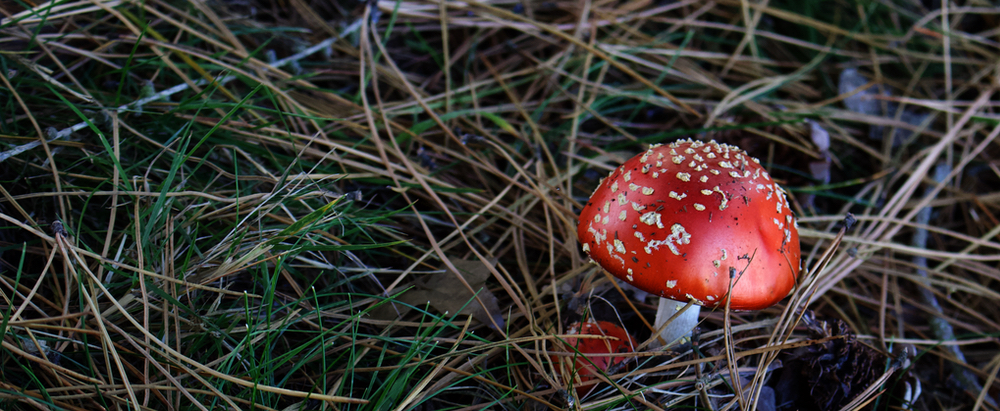
Harvesting Calendula, Lavender, Chamomile, and Catnip
Hello friends,
It's a very busy time in the garden with lots of harvesting to do, and last week I finally got around to harvesting chamomile, lavender, calendula, and catnip.



It was a bit of a battle to work around the many honey bees, bumble bees, and native bees who were all doing some harvesting of their own, but I finally got the flowers harvested.

The calendula and chamomile went straight into the dehydrator, but I had to chop the lavender stems back to make the lavender flowers fit inside. My dehydrator now lives in the garage, as the scented air flow sets off my asthma.


Once that was done, it was time to harvest the catnip. I grow our catnip in the berry cage, as it's the only way of getting a harvest for our indoor cats, Missy and Rosie, without the neighbourhood cats destroying it first. The catnip plants however had grown like weeds, and were far too large to fit inside the dehydrator.


After giving the branches a trim, luckily there was enough space inside the glasshouse walkway to fit them all in, so I laid the catnip out flat to dry. I put an old mesh door over the glasshouse during the day to stop the birds eating my tomatoes, but it also handily fends off the neighbourhood cats too.

Now that all the plants are dry, they go into storage for later on in the year. I plan to use the chamomile, calendula, and lavender in soap making once I have the time and space to do it. And the catnip will go into the cat's stash of catnip I keep all year for them.
Do you spoil your fur babies with their very own catnip? I find homegrown catnap is much more potent than store bought.
Have a wonderful day.
Julie-Ann
Want to discuss my post? Feel free to chat with me on Instagram or Mastodon.
Spring Seed Sowing Week 2
Hello friends,
It was a busy week seed sowing for Spring. I like to sow a mix of vegetable, herb, and flower seeds each week, so no individual job is too big at any one time.
Vegetable Seed Sowing this week:
- Pearl Drop Onions (for pickling)
- Italian Long Keeper Onions
- Pukekohe Long Keeper Onions
- Long White Spring Onions
- Santana Spinach
- Space Saver F1 Cabbage
- Summer Sprouting Purple Broccoli
- Coastline Lettuce
- Drunken Woman Fringed Lettuce
- Rocket
Herb Seed Sowing this week:
- Gigante Italian Parsley
- Celery for Cutting
- Soapwort
Flower Seed Sowing this week:
- Alyssum Painters Palette
- Alyssum Carpet of Snow
- Pansy Imperial Antique Shads
- Pansy Purple Lace
- Viola Clear Colour Mix
- Viola Frizzle Swizzle
- Viola Imperial Antique Shades
- Calendula Dwarf Colours Mixed
- Calendula Nova (herbal variety)
- Snapdragon Potomac Lavender
- Statice Apricot
- Night Scented Stock
- Spring Sparkle Stock
- Allium Purple Sensation
- Allium Showy Persian Onion
I have super easy way of seed sowing annual flowers, a cheat way really. I have a lot of self seeded annual plants in my flower garden beds, and I keep an eye out in late winter to see when plants like calendula, pansies, and alyssum start germinating. Once I see that the ground is warm enough for that to happen, it's time to sow annual seeds.

I gather all my annual seeds, and start opening all the packets. Here is where the lazy part is, I dump all the seeds into one container. And once all the seeds are mixed in all together I go out into the garden and start sprinkling seeds around where I want my annual plants to grow.
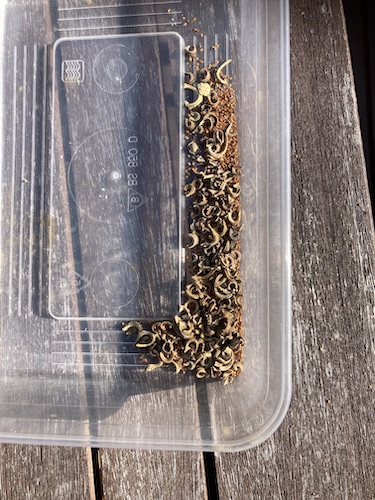
Within a couple of weeks all the annual seeds start germinating, and since I know what the seedlings all look like, I know not to weed them out of the ground. It may be lazy, but it saves me heaps of time in not having to sow each seed out by hand. I also like the wild, non structured feel of where the plants grow, as compared to all my other plants in the garden.
I have also just popped all my poppy seeds into the fridge to vernalise for two weeks. After that I will sow those seeds in a similar manner. I already have poppy plants that have self seeded into the garden as well, but I wanted to add even more coloured varieties this year.

How is your seed sowing going? With sunrise coming at least a minute earlier every single day, I can just feel the coming of Spring deep within my bones. The sky is no longer dark when I wake up in the morning, and I look forward to seeing the sun pop over the hills as I make breakfast each morning.
Have a wonderful day
Julie-Ann
Want to discuss my post? Feel free to chat with me on Instagram or Mastodon.
Spring Seed Sowing Week 1
Hello friends,
We're now into the last month of winter, and it's finally time to start sowing seed for spring. It's a tricky time of the year, as it's possible to get snow here in Dunedin even into the first week of October, so there's nothing worse than sowing seeds too early, and then having to try and keep them alive if there's a late frost or snow in early October. Last year we had snow laying on the ground the first week of October, and a couple of frosts the weeks after that, so it was a stressful time trying to keep all my seedlings alive, looking after my growing potato plants, as well as my new dahlias which had just popped out of the ground. Seedlings don't get transferred outside and into the vegetable garden until Labour Weekend, which is the third weekend of October, so that's a long way off right now.
I have a specific order in which to germinate seeds, so that I don't have too many plants sitting in the glasshouse for such a long period of time. The first seeds sown are my tomato plants. I grow enough plants for our own needs, but also for family members as well. I usually have at least 12 plants growing in our glasshouse, and poke any others that are spare in free space I have in the vegetable garden. We eat a lot of tomatoes fresh throughout the summer, but the bulk of it is frozen away for using in autumn and winter cooking.
This year I'm growing the following tomato varieties:
Franchi Sementi Pomodoro Red Cherry - A red cocktail tomato with great taste. This is no longer for sale in New Zealand, I save this seed every year.
Kings Honeybee F1 - I haven't tried this one before, I wanted to try another cocktail tomato, we'll see how this goes. One of my sister's grows her tomatoes outside, and it's far easier to ripen smaller tomatoes in Dunedin's short summers.
Kings Tomato Juane Flamme - Our favorite tomato, an orange tomato with the best taste of any tomato I've ever grown.
Tomato Grosse Lisse - A beefsteak tomato that was a favorite of my grandfather. The best tomato for putting a slice on a hot piece of toast, and eating it with a pinch of salt on top.
Tomato Island Bay Italian - I haven't grown this tomato variety before, but I've heard good things about it. Good for eating fresh and processing apparently.
Tomato Lebanese - Also a new tomato variety this year, I'm hoping it will have good disease resistance, and tastes good too.
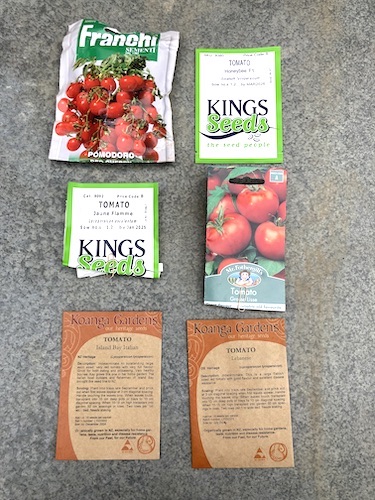
The next seeds to be germinated are my chilli and capsicums plants. I've successfully grown chillies in our greenhouse, but I haven't had any luck with the big traditional bell pepper capsicums.
This year I'll be growing the following chillies and peppers:
Chilli Serrano - I had a huge crop of chilli last season, so I'm growing this variety again.
Alma Paprika Pepper - Trying once again to grow my own paprika. Last season they didn't grow as well as I hoped, am trying again for the last time.
Capsicum Marconi Red - A prolific sweet Italian variety. I'm hoping that it's narrow shape will mean it ripens faster.
Capsicum Orange Sun - My last attempt at growing a bell pepper variety.
Capsicum Red Bell F1 - Also another last attempt at successfully growing a bell pepper variety.
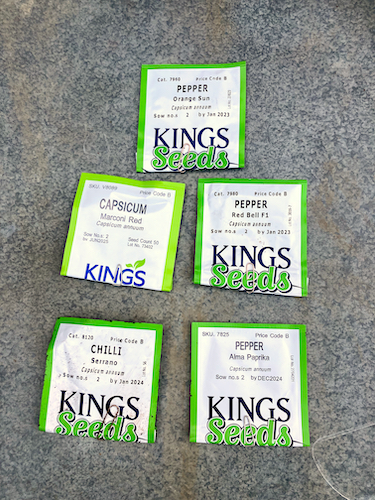
The tomato and chilli seeds were sown into two mini greenhouses, and placed in a warm sunny spot in our dining room. It's warm in there on sunny days, and also thanks to the benefit of our wood burner being in that room, they're kept warm in there every night in winter. I'm eagerly waiting for the seeds to germinate.
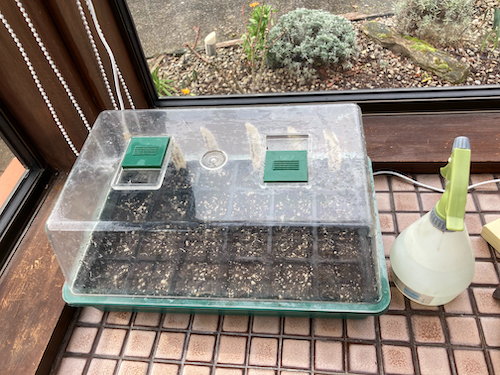
The next seeds to be sown are all my sweet pea varieties. I've collected quite a lot of Keith Hammett varieties over the years, he's a New Zealand breeder who produces the most stunning sweet peas. Sweet peas germinate in cool temperatures, so they are now potted up and put into the glasshouse.
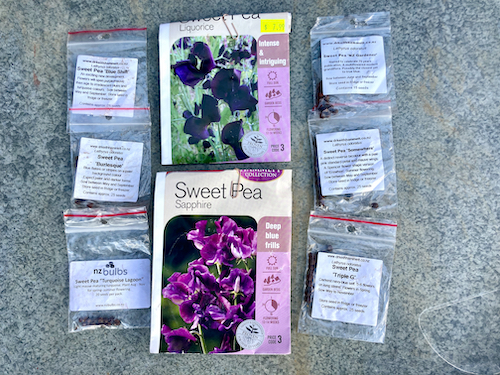
The last of the seeds to be sown for now are the herbs coriander and dill. Coriander prefers to grow in cool temperatures, otherwise they will bolt, so I sow one lot in late winter, and another in early autumn. They don't like to have their roots disturbed while planting into the ground, so I sow a bunch of seeds into a biggish pot, and then when it's time to transfer them into the herb garden, I plant the whole container worth in one spot, I don't separate out the seedlings at all. For the dill seeds I do the same thing as with the coriander, it ensures I get a relatively big crop of leaves without the problem of using up a lot space.
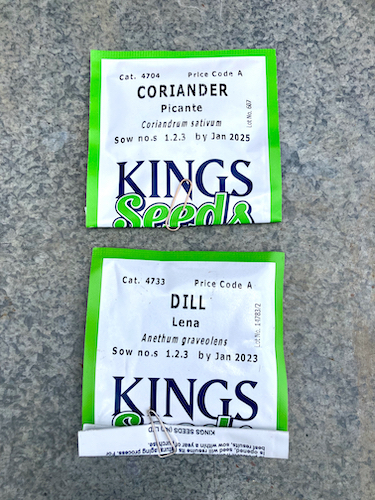
The sweet peas, coriander, and dill are all now sitting in my glasshouse. We're were expecting snow down to 200 m last night, so I've put off doing any more seed sowing tomorrow. Hopefully soon they will be joined by a lot more seeds as the month goes on.
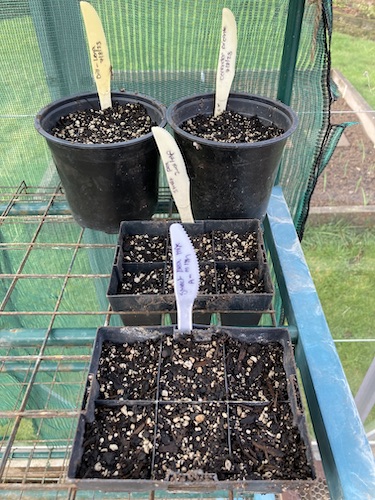
Have you started seed sowing yet? I'm interested in what choices you've made for the coming growing season.
Have a wonderful day
Julie-Ann
Want to discuss my post? Feel free to chat with me on Instagram or Mastodon.
The 2023 Kings Seeds Catalogue Has Arrived
Hello friends,
Down here in Dunedin, we are currently in the depth of winter. The winter solstice may have been a month ago, but now is the coldest time of the year for us, and will probably stay that way until late August at least. If it's not freezing cold and sunny, it's gray and rainy and soggy (and also still cold). Both outcomes mean not much can be done in the garden at the moment, on frosty days the ground is frozen solid, and on rainy days the garden is very squishy.
My frustration at not being able to get into the garden due to the weather has been made worse by me having minor toe surgery two weeks ago which has turned complicated thanks to an infection (as always, sigh). At the moment I can't fit my bandaged toe into any shoes (well apart from jandals), and if that wasn't bad enough, I'm not allowed to get my bandage and toe wet at all which would totally happen if I attempted to wear jandals in the garden right now. This pretty much means I have been confined to inside my home since the surgery, well apart from when I have to go to the doctors to get my dressing changed.
Just when I began to feel a little down about all this, one of the most exciting gardening days of the year happened, the arrival of the 2023/2024 Kings Seeds Catalogue. There's nothing like ripping open the packaging, sniffing that new magazine smell, and then flipping through the pages to see what seed goodies are available this year.


The first responsible thing to do though is to go through my current flower, herb and vegetable seed stashes and see what I have, there's no point in buying seed when I have plenty stored away already. My seed stashes are split into three sections, flowers, herbs, and vegetables. The flowers and herbs seeds are in disorganized chaos inside some plastic tubs.


The vegetable seeds however are meticulously organized in a craft storage box from Spotlight. It has lots of small containers which I use to separate the vegetable seeds based on each vegetable type. And thanks to my handy dandy label maker I know exactly which container is which. I also use the coloured boxes to match each vegetable type, and this makes it super easy to find the corn and carrot boxes for example.
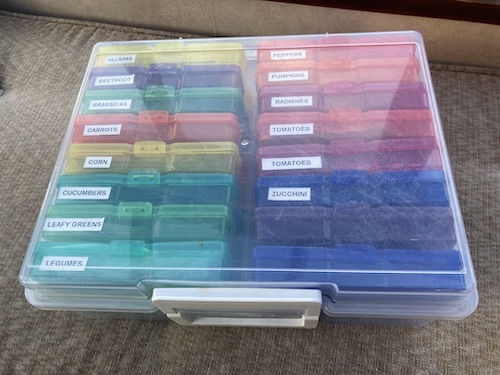

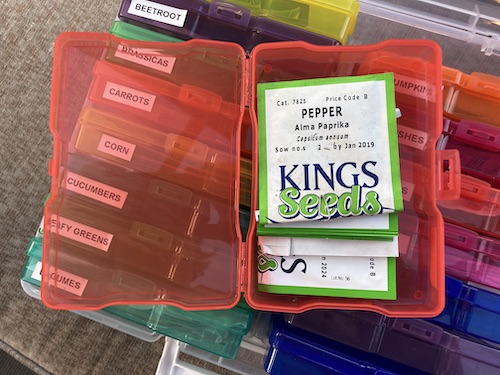
After I pull out each box I open my garden seed database and check each seed packet, and their use by date, and update the database accordingly. If any seeds are low, or finished, I highlight the database to show which seeds I need to reorder. My database also includes a section to show what times of the year the seed can be sown, and when it has been sown. It's been very handy over the years as long as it's been kept updated.
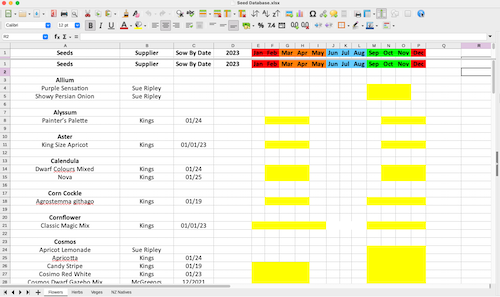
Once that is completed, it's time to browse the Kings Seeds catalogue. On the first go through I highlight all the things I need, and those that I want. I let myself go wild. After that is done, I knuckle down and make post it notes lists. This list is more focused, and I make a point of deciding things like if I do really need three different varieties of calendula...
After that, the next step is going onto the website. First of all I add stuff to the cart that we absolutely really need. After that I narrow down the other stuff I want and put it in the cart. Sometimes the seeds that I need and want appear in the Kings Seeds shopping rewards list (they have a system where after you spend a certain amount they give you free seed packets). Then I tend to juggle the cart based on if some of my seeds will end up on that list, there's no point wasting money on what will be free seeds.

After all that is done, and I've justified to myself every seed packet in the cart, it's time to pull out the credit card and pay for all my precious seeds. And then the waiting at the letterbox begins...it's nearly just as exciting sorting through all the new seed packets when they arrive.
Are you buying and growing any new varieties of plants this year in your garden? Do you have a seed database like I do? I'd be interested to find out.
Have a wonderful day
Julie-Ann
Want to discuss my post? Feel free to chat with me on Instagram or Mastodon.
Planting Miniature Irises for Spring
Hello friends,
I can't resist a good plant catalogue, well any plant catalogue really. If one shows up in my mailbox with the plants all decked out in bright and colourful flowers, how can I resist buying bulbs in autumn for the coming spring?
Well I can't of course, and especially when they're tempting me with miniature plants. As you will see in spring, for some time I have been adding to my crocus and Tete a Tete daffodil collections. The tinier the plants the better, in my opinion.
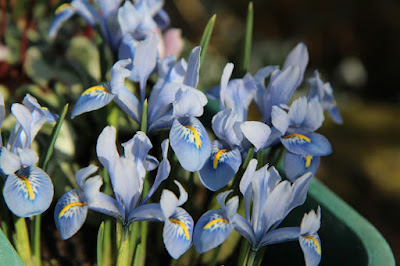
Well this time the Garden Post plant catalogue offered me miniature irises. Teeny tiny irises that would be only 15 cm tall at most, and would be one of the first bulbs to flower in spring. Before I knew what I was doing, four different varieties were in my online shopping cart, and it wasn't too long before 28 bulbs arrived by courier. I ordered miniature irises in shades of blue and purple (Alida, Blue Note, J.S. Dijt, and Painted Lady).
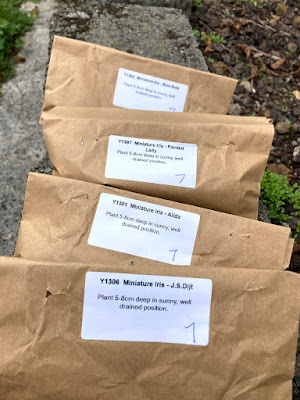
The next weekend I weeded an area of the back garden, near a very small plastic pond with a waterfall that is solar powered. I pulled out my trusty bulb planter I bought a couple of years ago, and got to work.
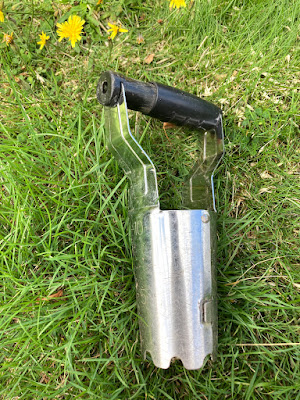
I use my bulb planter for not only flower bulbs, but garlic bulbs also. The planter has a handy measurer on the side, so you know how deep to dig the soil depending on what bulb type you are planting. When you pull the plug of soil out of the ground with the planter, you just pop your bulb of choice into the hole, and then by squeezing the handle, it will release the soil back into the ground. If you are planting large amounts of bulbs, the planter will not only save you time, but also wear and tear on your joints too.
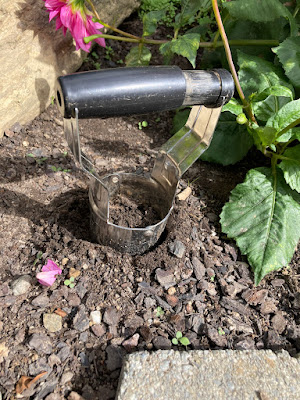
It wasn't long until all my new precious bulbs were in the ground. And now I wait, through all of autumn, and then winter, and hopefully fingers crossed, as we move into spring, my new miniature irises will appear. I can't wait to photograph them in all their glory.

Autumn has been such a busy time of year with many harvests and processing of produce happening at the moment. But not only that, I've recently had sinus surgery, followed, by a small complication, and now a sinus infection. I'm hoping to continue recovering from both the surgery, and the infection very soon, so I can get back out into the garden. The weeds are taking over, even though the weather is cooling considerably.
Have a wonderful day.Julie-Ann
Want to discuss my post? Feel free to chat with me on Instagram or Mastodon.




